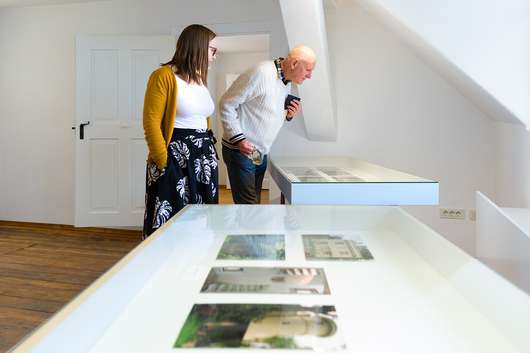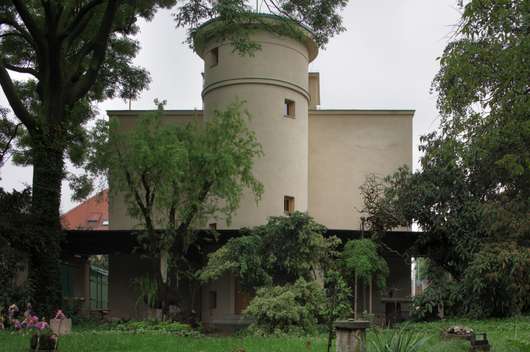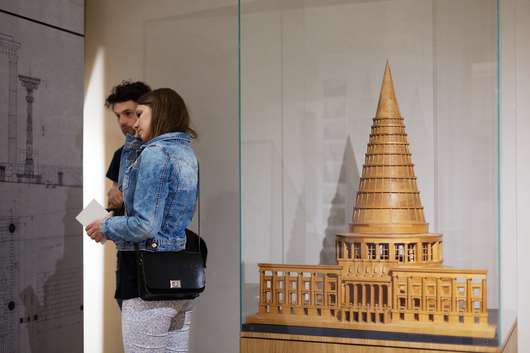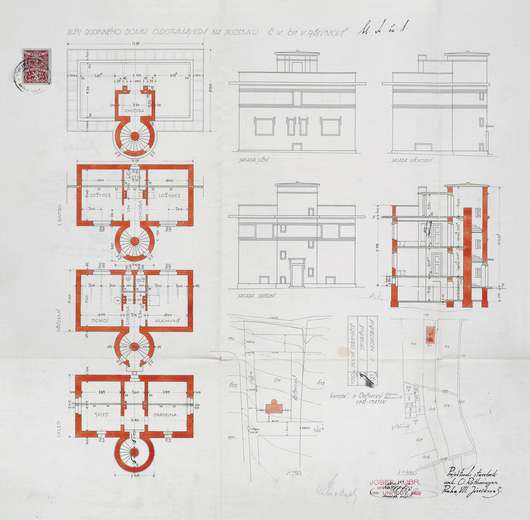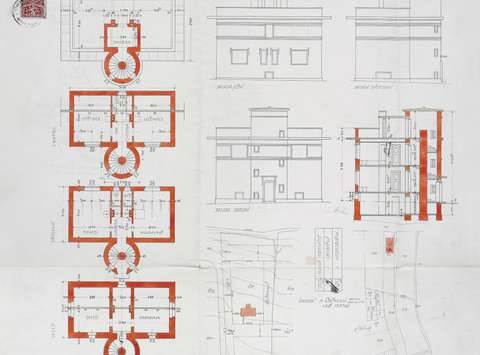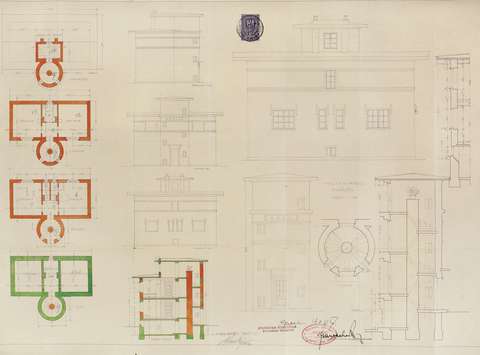Plečnik and Rothmayer
Two Friends, Two Houses, Two Cities
Jože Plečnik and Otto Rothmayer, a Slovenian and a Czech architect, collaborated closely in the renovation of Prague Castle, during which time a friendship formed between the two.
Rothmayer designed his home in Prague, after receiving approval from Plečnik, according to Plečnik's plans for the Villa Stadion. Nowadays, the Villa Rothmayer in Prague is a public museum that offers an insight into the life of this important Czech architect.
The exhibition at the Plečnik House, prepared by The City of Prague Museum, presents the recently renovated and now publicly accessible house of the Czech architect Otto Rothmayer. It also gives a comparison with the nearly identical Villa Stadion, designed by Jože Plečnik in Ljubljana. Rothmayer – a former student of Plečnik, who became a collaborator and a close friend – often visited Ljubljana. He actually used Plečnik's plans for Villa Stadion as the basis for his home in Prague, which he completed in 1929.
The exhibition is complemented by contemporary colour photographs by Martin Polák, which are simultaneously poetic and realistic, as well as numerous historical black and white photos from Otto Rothmayer's archive. All of them present the house in Prague with its romantic garden not only as an architectural and cultural monument, but equally as a place in which the architect, his family, and friends enjoyed a rich cultural and intellectual life.
PROGRAMME ACCOMPANYING THE EXHIBITION
1. 2. 2018 at 6 p.m.
Plečnik and Rothmayer, lecture by the exhibition author Petr Krajči (in English); confirm your attendance in advance on prijava@mgml.si or by phone: 01 24 12 506.
8. 2. 2018, 10 a.m.–9 p.m., Prešeren Day, the Slovene Cultural Holiday
Free entrance to the Plečnik House, including the permanent and temporary exhibitions and tours of Plečnik’s authentic home. Confirm your attendance in advance (6 and 7 February) on prijava@mgml.si.
21. 3. 2018 at 5 p.m.
Guided tour of the exhibition with Ana Porok, curator of the Plečnik House. Confirm your attendance in advance on prijava@mgml.si or 01 24 12 506.
5. 5. 2018 at 11 a.m.
Guided tour of the exhibition with Petr Krajči, author of the exhibition. Confirm your attendance in advance on prijava@mgml.si or 01 24 12 506.
FROM THE EXHIBITION BROCHURE
The recently restored and now publicly accessible Villa Rothmayer, built in the Prague suburb of Břevnov in 1929, has its model in a one-year-older dwelling in Ljubljana near the Bežigrad Stadium – the Villa Stadion by Jože Plečnik. The latter was constructed to serve as the grand prize in a public raffle to aid the athletics association Orel in the construction of the stadium. Plečnik inserted in the archetypal volume of the building – a simple upright prism to which he added a staircase tower in a vertical cylinder (both designed with the most refined proportions) – a single below-ground level for utilities, and above it two floors with living areas and necessary facilities. The house ends in the prismatic volume of the winter garden rising from the peaked roof with a low pitch, typical in Mediterranean architecture.
The Czech architect Otto Rothmayer (1892–1966) – Plečnik’s student, collaborator, and later also a close friend, whom Plečnik in fact selected in 1921 as his representative for the renovation of Prague Castle – frequently visited Ljubljana. Evidently, he saw and appreciated Plečnik’s plan for the Villa Stadion during one of these visits, which eventually became the basis for the design of his own family residence. The design for a small dwelling with a simple floor plan and spatial design, decorated with only ornamental friezes on the facade, was altered by Rothmayer, after many consultations with Plečnik, to match his own architectonic sensibility. The spatial format was repeated precisely, yet the use of individual rooms was adapted to the needs of the Rothmayer family, and the building was oriented towards what had previously been an open field. This latter factor also had a significant influence on the façade, leading to the addition of more windows to bring natural light into the kitchen and three rooms. The different use of rooms in both houses can be compared on the preserved original blueprints. The Prague villa is simpler in its expression, without decorative ornaments, and in place of the low-pitched roof Rothmayer designed a flat terrace for the sweeping views. One of the most intriguing parts of the house is unquestionably the comfortable cylindrical staircase with its simple, yet aesthetically effective architectonic details.
Nearly two decades of shared work in remodelling Prague Castle and the Czech presidential residence in the village Lány, enlivened by Rothmayer’s visits to Ljubljana and Plečnik’s to Prague, led the two architects into a close personal bond. Hence it is not surprising that Villa Rothmayer also contains artistic moments or architectural details similar to those found in Plečnik’s house in Trnovo, where the cylindrical element forms an invisible connection between Prague and Ljubljana. Though the creative collaboration between the two architects ended once President T. G. Masaryk left office in 1934, and Plečnik had already settled permanently in Ljubljana, their friendship persisted.
The house in Prague, with its adjoining and increasingly rich garden, became the home of the Rothmayers for nearly eighty years, and also a safe refuge in difficult times. Today, the villa and its garden are a recognised architectural and cultural landmark, yet in earlier years they played host to lively social meetings and the spiritual life of the family and its friends, such as the great photographer Josef Sudek or the sculptor-couple Bedřich Stefan and Hana Wichterlová. Recalling the enchantment of simplicity that is so visible in the house even today, we should also not forget the role of the architect’s wife, Božena Rothmayerová, née Horneková (1899–1984), an important textile designer, pedagogue and tireless promoter of a simpler lifestyle. The author of a well-conceived wardrobe for the modern woman, she worked for her entire life to create an environment of refinement and cultivation, and a reliable home for her husband and son.
History prepared quite different fates for the two houses. The Villa Stadion, which – devoid of its frescos and with a ground-level addition – today stands in Mariborska Street, is not open to the public. As for Prague’s Villa Rothmayer, it has become, largely thanks to the architect’s son Jan, a major Czech photographer and student of Josef Sudek, a publicly accessible monument of interwar modern architecture, administered along with the renowned Villa Müller by Adolf Loos by The City of Prague Museum. An extensive series of black-and-white photographs, acquired primarily from the Rothmayer family archive, provide a full image of the history of these two houses and the ‘minor narrative’ of a single artistic family. The contemporary colour photographs by Martin Polák, poetic and realistic at once, in turn give us an accurate sense of the current state of the Prague villa and invite us to pay it a visit.
Petr Krajči
Colophon
Museum and Galleries of Ljubljana, Plečnik House, represented by: Blaž Peršin, Director
The exhibition was prepared by: The City of Prague Museum, Centre of Monuments of Modern Architecture, represented by: Zuzana Strnadová, Director
Author of the exhibition and texts: Petr Krajči
Curator: Maria Szadkowska
Expert consultant: Ana Porok
Production of the exhibition: Zuzana Hronková, Maja Kovač, Eva Bolha
Preprint preparation: Markéta Othová
Historical black and white photographs by: Zdeněk Kříž, Jan Rothmayer, Otto Rothmayer, Peter Naglič, Božena Rotmayerová, Jože Plečnik
Contemporary colour photographs by: Martin Polák
Reproductions from the Czech journal Tvar XIII, 1962, no. 4, Tvar XXI, 1970, no. 2 and the exhibition catalogue “The Civilised Woman: How a Cultivated Woman Should Dress”, Brno 1929
Plan for Villa Rothmayer in Prague: The City of Prague Museum
Plan for Plečnik's Villa Stadion in Ljubljana: Ljubljana Historical Archive
Short film: Václav Hron and The City of Prague Museum
Graphic and exhibition design: Bojan Lazarevič, Agora Proars
Language editing: Katja Paladin
Slovene translation: Matic Šavli
English translation: Martin Tharp
Promotion: Maja Kovač, Tamara Bregar
Exhibition layout: OKvir, Technical services of MGML
Location
Karunova 4–6
1000 Ljubljana
T +386 1 280 16 04 (reception)
T +386 1 241 25 06
E plecnik@mgml.si
Opening hours
Tuesday–Sunday: 10:00–18:00
Monday: Closed
1 January, 1 November, 25 December: Closed
24 and 31 December: 10:00–14:00
Tickets
Visits of the original Plečnik’s home are only possible with a guided tour that begins every full hour. In case the visitors on the guided tours come from different countries, each tour is conducted in two languages – Slovenian and English.
RECOMMENDED: you can buy your tickets online and book your date here.
For more information, please contact plecnik@mgml.si or +386 1 280 16 04.
Visiting the Plečnik House (price includes permanent exhibition Plečnik and a guided tour of Plečnik's home)
Adults: 9 €
Students: 7 €
Children: 7 €
Children up to the age of 6: Admission free
Adults over the age of 60: 7 €
Families: 18 €
Unemployed visitors: 7 €
Visitors with disabilities: 7 €
Free admission for carers
ICOM, PRESS, SMD: free admission
Guided tours for private groups of more than 7 visitors need to be booked at least 5 working days in advance.
Visiting the Plečnik House with a prior reservation
Groups of up to 5 persons: 50 €, 40 € at reduced price
Groups of over 5 persons: 10 €/person, reduced 8 €/person
Visiting the permanent exhibition Plečnik
Adults: 6 €
Students: 4 €
Children: 4 €
Children up to the age of 6: Admission free
Adults over the age of 60: 4 €
Families: 12 €
Unemployed visitors: 4 €
Visitors with disabilities: 4 €
Free admission for carers
ICOM, PRESS, SMD: free admission
News
"Plečnik and Rothmayer. Teacher and student. The latter built his home in Prague according to Plečnik’s Villa Stadion in Ljubljana, built due to the Bežigrad stadium. By buying a ticket for the lottery raffle, people were able to support the stadium’s construction and had a chance of winning the grand prize – the Plečnik villa." We are inviting you to watch the TV Slovenia coverage of the exhibition Plečnik and Rothmayer: Two Friends, Two Houses, Two Cities.
The Plečnik House 2018 exhibition programme will focus on Plečnik's work, the achievements of his collaborators, and on establishing Plečnik's oeuvre as an inspiration for contemporary creativity.
Events
